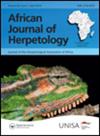短柄细尾蛙的形态和遗传变异包括来自加蓬的鲜为人知的树蛙结晶细尾蛙和来自赤道几内亚比奥科岛的短尾细尾蛙
IF 0.9
4区 生物学
Q3 ZOOLOGY
引用次数: 3
摘要
摘要:中非树蛙短吻细腹蛙具有典型的短而垂直的吻部,下颌骨中心有一个齿状突起,与大多数细腹蛙不同,它以陆生腹足类为食。两个形态相似的物种(结晶乳杆菌和短乳乳杆菌)在与短乳乳乳杆菌的同域中被描述,每个物种都基于一个雌性标本,随后的作者将其与短乳杆菌暂时同义。在这里,我们重新检查了这三个物种的正模,并收集了短花乳杆菌及其姊妹种注释乳杆菌的遗传(mtDNA和25个nuDNA基因座)和形态学数据,以检验短花乳球菌由一个以上物种组成的假设。我们发现结晶乳杆菌(缺乏可见的鼓室,接触有较大的vomerine牙齿)和短乳杆菌(独特的背侧着色)的诊断特征也存在于短乳杆菌和标记乳杆菌中。此外,这些特征在共享相同线粒体单倍型并出现在单个位置的个体之间有所不同,包括结晶乳杆菌的类型位置。尽管来自结晶乳杆菌类型区的所有样本相对于短乳乳杆菌和短花乳杆菌形成了不同的线粒体谱系,但我们对25个核基因座的分析并不支持这种关系,而是表明这种线粒体差异反映了短花乳菌范围内的系统地理结构,包括来自结晶乳杆菌和短乳乳杆菌的类型部位的样品。相比之下,在nuDNA数据集中,L.nottus和L.brevicostris之间的线粒体差异得到了有力的支持。因此,我们认识到L.brevipes和L.crystinoron都是L.brevirostris的同义词。鉴于从一个地方采集的短喙乳杆菌在颜色模式、鼓膜以及vomerine牙齿的大小和形状方面存在广泛的差异,在对细齿乳杆菌的分类学研究中,应谨慎解释这些特征的变化。本文章由计算机程序翻译,如有差异,请以英文原文为准。
Morphological and genetic variation of Leptopelis brevirostris encompasses the little-known treefrogs Leptopelis crystallinoron from Gabon and Leptopelis brevipes from Bioko Island, Equatorial Guinea
ABSTRACT The Central African treefrog Leptopelis brevirostris has a characteristically short and vertically truncated snout, a tooth-like process at the centre of the mandible, and unlike most species of Leptopelis, eats terrestrial gastropods. Two morphologically similar species (L. crystallinoron and L. brevipes) have been described in sympatry with L. brevirostris, each on the basis of a single female specimen and then provisionally synonymised with L. brevirostris by subsequent authors. Here we re-examine the holotypes of the three species and collect both genetic (mtDNA and 25 nuDNA loci) and morphological data across the range of L. brevirostris and its sister species L. notatus to test the hypothesis that L. brevirostris is comprised of more than one species. We found that the diagnostic characters for L. crystallinoron (lacking a visible tympanum and having larger vomerine teeth in contact) and L. brevipes (distinctive dorsal colouration) are also present in L. brevirostris and L. notatus. Furthermore, these characters vary among individuals that share the same mitochondrial haplotype and that occur within a single locality, including the type locality of L. crystallinoron. Although all samples from the type locality of L. crystallinoron form a distinct mitochondrial lineage relative to L. brevipes and L. brevirostris, our analysis of 25 nuclear loci does not support this relationship and instead suggests that this mitochondrial divergence reflects phylogeographic structure across the range of L. brevirostris, including samples from the type localities of L. crystallinoron and L. brevipes. By contrast, the mitochondrial divergence between L. notatus and L. brevirostris is strongly supported in the nuDNA dataset. Consequently, we recognise both L. brevipes and L. crystallinoron as synonyms of L. brevirostris. Given the extensive variation in the colour pattern, the tympanic membrane, and the size and shape of the vomerine teeth among L. brevirostris collected from one locality, variation in these traits should be interpreted with caution in taxonomic research on Leptopelis.
求助全文
通过发布文献求助,成功后即可免费获取论文全文。
去求助
来源期刊

African Journal of Herpetology
ZOOLOGY-
CiteScore
3.00
自引率
6.70%
发文量
15
审稿时长
>12 weeks
期刊介绍:
African Journal of Herpetology (AJH) serves as an outlet for original research on the biology of African amphibians and reptiles. AJH is an interdisciplinary journal that publishes original articles and reviews from diverse fields and disciplines, such as conservation, phylogenetics, evolution, systematics, performance, physiology, ecology, behavioural ecology, ethology, and morphology.
The Journal publishes two issues a year. There are no page charges .
 求助内容:
求助内容: 应助结果提醒方式:
应助结果提醒方式:


